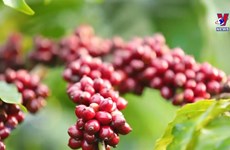China cassava processors seek partners
More than 30 Chinese cassava importers and suppliers of cassava
processing technology met local businesses on Sept.7 in HCM City to
exchange information and seek business partners.
More than 30 Chinese cassava importers and suppliers of cassava
processing technology met local businesses on Sept.7 in HCM City to
exchange information and seek business partners.
The meeting was arranged by the Trade Promotion Agency under the Ministry of Industry and Trade, the China Trade Office in Vietnam , the China Cassava Starch Industry Association and the Vietnam-China Trade Promotion Centre.
Cassava, an edible root, has become an increasingly profitable export for Vietnam due to growing demand in foreign markets, said Le Xuan Duong of the Trade Promotion Agency.
Mainland China is the biggest importer of Vietnamese cassava, accounting for 90 percent of the industry's export volume, followed by the Republic of Korea and Taiwan , Duong said.
With the huge demand for cassava used to produce food, animal feed and ethanol-blended petrol, China every year needs to import more than six million tonnes of cassava to meet its production needs, he said.
Vietnam has more than 500,000ha under cassava cultivation and an output of more than nine million tonnes of fresh cassava a year.
Of this, it annually exports more than four million tonnes after meeting domestic demand.
Vietnam 's cassava exports are mostly starch powder and dried chips, Duong said.
Last year, the country earned 800 million USD from cassava exports, double that of pepper shipment revenues.
However, Vietnam was only able to export 1.14 million tonnes of cassava worth 307 million USD in the first six months of this year, down 52.4 percent in volume and 12.8 percent in value compared to the same period last year.
Duong attributed this decline mainly to local traders setting prices too high, pushing importers to buy from other countries.
Wen Yu Ping, Chairwoman of the China Cassava Starch Industry Association, said China was a huge market for cassava chips and starch, but most cassava products in Vietnam were produced on a small-scale, making it difficult for Chinese importers to purchase in large volumes. She suggested that the Vietnamese Government regulates standards for cassava export and reduce the number of brokers involved in purchasing the products. These measures will facilitate import, export activities between two sides, she said.
Until recently, people were reluctant to grow cassava because they thought that it caused soil degradation and generated low profit, said Tran Cong Khanh, an expert from the Institute of Agricultural Science for Southern Vietnam .
The situation has changed after the introduction of new cultivation techniques and high-yielding varieties, he added.
Cassava is now an important source of income for small farmers in many provinces, Khanh said.
Cassava area and output have increased strongly in the last decade, from 234,000ha in 2000 to 560,000ha in 2009, with yields increasing from 8.6 tonne per ha in 2000 to 16.8 tonne per ha in 2009.
The crop has helped farmers in many areas escape poverty, Khanh said.
But the rapid development of cassava production has also raised environmental concerns because the soil is exhausted after two or three crops.
The sector therefore needs to adopt appropriate cultivation techniques to maintain output and protect the soil, Khanh cautioned. /.
The meeting was arranged by the Trade Promotion Agency under the Ministry of Industry and Trade, the China Trade Office in Vietnam , the China Cassava Starch Industry Association and the Vietnam-China Trade Promotion Centre.
Cassava, an edible root, has become an increasingly profitable export for Vietnam due to growing demand in foreign markets, said Le Xuan Duong of the Trade Promotion Agency.
Mainland China is the biggest importer of Vietnamese cassava, accounting for 90 percent of the industry's export volume, followed by the Republic of Korea and Taiwan , Duong said.
With the huge demand for cassava used to produce food, animal feed and ethanol-blended petrol, China every year needs to import more than six million tonnes of cassava to meet its production needs, he said.
Vietnam has more than 500,000ha under cassava cultivation and an output of more than nine million tonnes of fresh cassava a year.
Of this, it annually exports more than four million tonnes after meeting domestic demand.
Vietnam 's cassava exports are mostly starch powder and dried chips, Duong said.
Last year, the country earned 800 million USD from cassava exports, double that of pepper shipment revenues.
However, Vietnam was only able to export 1.14 million tonnes of cassava worth 307 million USD in the first six months of this year, down 52.4 percent in volume and 12.8 percent in value compared to the same period last year.
Duong attributed this decline mainly to local traders setting prices too high, pushing importers to buy from other countries.
Wen Yu Ping, Chairwoman of the China Cassava Starch Industry Association, said China was a huge market for cassava chips and starch, but most cassava products in Vietnam were produced on a small-scale, making it difficult for Chinese importers to purchase in large volumes. She suggested that the Vietnamese Government regulates standards for cassava export and reduce the number of brokers involved in purchasing the products. These measures will facilitate import, export activities between two sides, she said.
Until recently, people were reluctant to grow cassava because they thought that it caused soil degradation and generated low profit, said Tran Cong Khanh, an expert from the Institute of Agricultural Science for Southern Vietnam .
The situation has changed after the introduction of new cultivation techniques and high-yielding varieties, he added.
Cassava is now an important source of income for small farmers in many provinces, Khanh said.
Cassava area and output have increased strongly in the last decade, from 234,000ha in 2000 to 560,000ha in 2009, with yields increasing from 8.6 tonne per ha in 2000 to 16.8 tonne per ha in 2009.
The crop has helped farmers in many areas escape poverty, Khanh said.
But the rapid development of cassava production has also raised environmental concerns because the soil is exhausted after two or three crops.
The sector therefore needs to adopt appropriate cultivation techniques to maintain output and protect the soil, Khanh cautioned. /.













